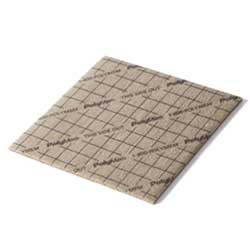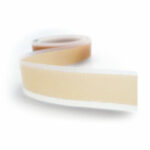PolyMem Silver -haavasidos
PolyMem Silver -haavasidos sisältää pienhiukkasista hopeaa ja se sopii infektioalttiin tai jo infektoituneen haavan hoitoon. PolyMem Silver ei luovuta hopeapartikkeleita haavalle. PolyMem Silver on haavaan tarttumaton ja sen ainesosat puhdistavat haavaa aktiivisesti.
Käyttökohteet
- Infektoituneille haavoille
- Säärihaavoille
- Traumahaavoille
- Kivuliaille haavoille
Kaikki PolyMem-haavasidokset sisältävät hoitavia ainesosia, jotka aktivoituvat haavaeritteestä
F68 – myrkytön, pinta-aktiivinen haavanpuhdistaja. Pinta-aktiivisena se tunkeutuu haavapohjan ja katteen väliin, helpottaen haavan mekaanista puhdistamista.
Glyseriini pehmentää nekroottista kudosta ja ennaltaehkäisee sidoksen tarttumista haavaan.
Superabsorbentti antaa sidokselle tehokkaan imukyvyn.
Puoliläpäisevä taustakalvo auttaa säilyttämään haavalla optimaalisen lämmön ja kosteuden.
Pienhiukkainen hopea tappaa haavan epäpuhtaudet ja mikrobit, eikä se vapaudu potilaaseen.
| Tuotenumero | Tuotekuvaus | Pakkauskoko |
| 1022 | 4,7 x 4,7 cm | 20 |
| 1044 | 10 x 10 cm | 15 |
| 1077 | 17 x 19 cm | 15 |
| 1124 | 10 x 31 cm | 12 |
90-vuotiaan naisen vasemman säären haavanhoito PolyMem-haavasidoksilla
65-vuotiaan miehen jalkaterän palovamman hoito PolyMem-sarjan sidoksilla
96-vuotiaan säärihaavan hoito PolyMem-sidoksilla
50 vuotiaan miehen jalkaterän palovamman hoito PolyMem Silver ja Medihoney HCS -sidoksilla
Käsivarren palovamman hoito PolyMem-haavasidoksilla ja Microdacyn60-haavahuuhteella
Napatyräleikkaushaavan hoito PolyWic-syvähaavasidoksella
PolyMemin vaikutuksesta haavakivun vähenemiseen voit lukea seuraavista viitteistä:
– Huomattava kivun lievittyminen16, 17, 19, 20, 21
– Väheneminen tulehdusreaktion leviämisessä vaurioitumattomiin ympäröiviin kudoksiin16, 20
– Edeeman huomattava vähentyminen16, 20
– Mustelmien huomattava vähentyminen16
– Haavan tai vamman lyhentynyt parantumisaika16, 20,22
- Lanser P, Gessell S. Pain management: the fifth vital sign. Healthcare Benchmarks. June 2001;8(6):68-70
- Yuen TST. The “Fifth Vital Sign.” Hong Kong Medical Journal. June 2005;11(3):145-146
- Pain Management. United States of America. Department of Veterans Affairs, Veterans Health Administration. VHA Directive 2003-021. May 2, 2003
- Hofman D, Ryan TJ, Arnould F, Cherry GW, Lindholm C, Bjellerup M, Glynn C. Pain in venous leg ulcers. Journal of Wound Care May 1997; 6(5):222-4.
- Ebbeskog B., Lindholm C., Ohman S., Scandinavian Journal of Primary Health Care 1996;14(4):238-243
- Dallam L, Smyth C, Jackson BS, et al. Pressure ulcer pain: Assessment and Quantification. Journal of Wound Ostomy Continence Nursing 1995; 22:211-8.
- Moffat CJ, Franks, PJ, Hollingworth H. Understanding wound pain and trauma: an international perspective in European Wound Management Association Position Document Pain at Wound Dressing Changes, Medical Education Partnership, London UK, 2002; pages2-7
- Middleton C. Understanding the physiological effects of unrelieved pain. Nursing Times. September 16, 2003; 99(37):28-31
- Clay CS, Chen WYJ. Wound pain: the need for a more understanding approach. Journal of Wound Care. April 2005;14(4):181-184
- Abraham SE. Pain Management in wound care. Podiatry Management. June/July 2006:165-168
- Wulf H, Baron R. The Theory of Pain in European Wound Management Association Position Document Pain at Wound Dressing Changes, Medical Education Partnership, London UK, 2002; page 8-11
- Levine JD, Reichling DB. Chapter 2 Peripheral Mechanisms of Inflammatory Pain. In Wall PD, Melzak R, Editors. Textbook of Pain. 4th edition. Edinburgh, UK: Churchill Livingstone, 1999. pages 59-84.
- Fields HL. Chapter 1 Introduction & Chapter 2 The Peripheral Pain Sensory System In Pain New York; McGraw-Hill 1987 pages 1-40
- Holzer P , Maggi CA. Dissociation of Dorsal Root Ganglion Neurons into Afferent and Efferent-like Neurons Neuroscience, 1998; 86(2):389-398
- Kumazawa T. Primitivism and plasticity of pain-implication of polymodal receptors, Neuroscience Research. 1998; 32:9-31
- Kahn AR. A Superficial Cutaneous Dressing Inhibits Pain, Inflammation and Swelling In Deep Tissues; , Poster # 600 World Pain Conference, July 15-21, 2000. Pain Medicine 2000; 1(2): 187
- Hayden JK, Cole BJ. The effectiveness of a pain wrap compared to a standard dressing on the reduction of post-operative morbidity following routine knee arthroscopy: A prospective randomized single blind study. Orthopedics, 2003; 26:59-63
- Foresman PA, Ethridge CA, Rodeheaver G. A wound healing evaluation on partial-thickness rat wounds. Symposium on Advances in Skin and Wound Care. 1991 Annual Meeting. Poster Presentation. Health Management Publications
- Benskin L. Crush injury treated with PolyMeric Membrane dressings until complete wound closure. Presented at 19th annual Symposium on Advanced Wound Care (SAWC). Poster #32, April 30-May 2, 2006. San Antonio, TX, USA.
- Beitz AJ, Newman A, Kahn A R. Ruggles T, Eikmejer L. A Polymeric Membrane Dressing With Antinociceptive Properties: Analysis With a Rodent Model of Stab Wound Secondary Hyperalgesia; The Journal of Pain, February, 2004; 5(1):38-47.
- Benskin L. Dramatic Pain Relief through the use of PolyMeric Membrane Dressings (with and without silver) on a deep axillary wound;. Presented at19th annual Symposium on Advanced Wound Care (SAWC). Poster #96, April 30-May 2, 2006. San Antonio, TX, USA.
- Kim YK , Lee SW , Hong SH. The effects of PolyMem on the wound healing. J Korean Soc Plast Reconstr Surg 1999; 109:1165-72.
- Minimising pain at wound dressing-related procedures. A consensus document. Principles of Best Practice. A World Union of Wound Healing Societies’s Inititiative. Medical Education Partnership (MEP Ltd) London UK 2004
Kysy lisää tästä tuotteesta
Puhelin +358 9 417 606 00
Sähköposti steripolar@steripolar.fi
"*" pakollinen kenttä




